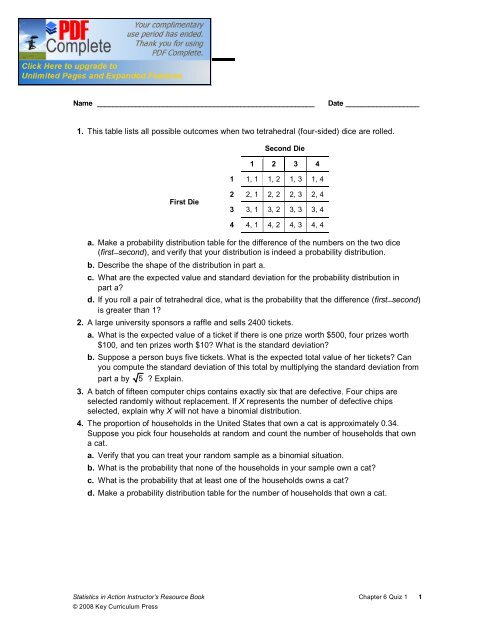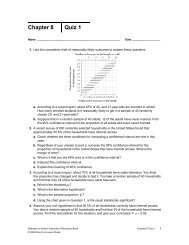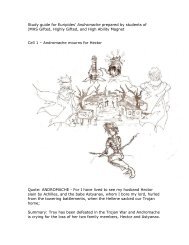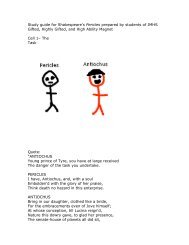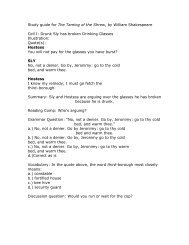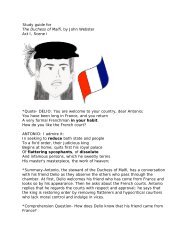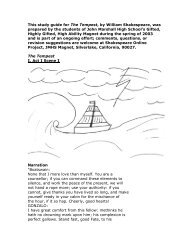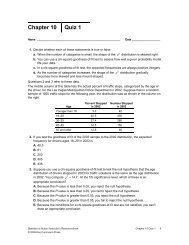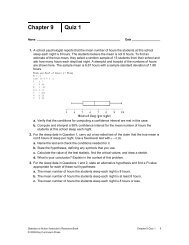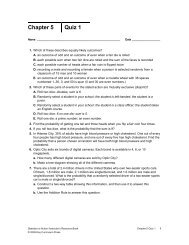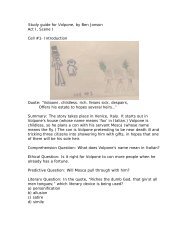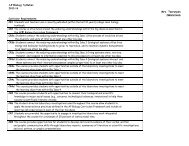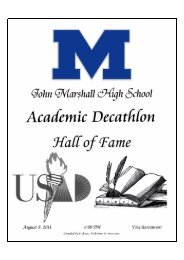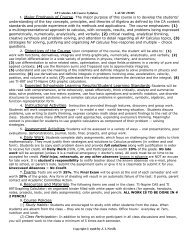Chapter 6 Assessm...pdf
Chapter 6 Assessm...pdf
Chapter 6 Assessm...pdf
You also want an ePaper? Increase the reach of your titles
YUMPU automatically turns print PDFs into web optimized ePapers that Google loves.
<strong>Chapter</strong> 6 Quiz 1Name ________________________________________________________Date ___________________1. This table lists all possible outcomes when two tetrahedral (four-sided) dice are rolled.Second Die1 2 3 41 1, 1 1, 2 1, 3 1, 4First Die2 2, 1 2, 2 2, 3 2, 43 3, 1 3, 2 3, 3 3, 44 4, 1 4, 2 4, 3 4, 4a. Make a probability distribution table for the difference of the numbers on the two dice(firstsecond), and verify that your distribution is indeed a probability distribution.b. Describe the shape of the distribution in part a.c. What are the expected value and standard deviation for the probability distribution inpart a?d. If you roll a pair of tetrahedral dice, what is the probability that the difference (firstsecond)is greater than 1?2. A large university sponsors a raffle and sells 2400 tickets.a. What is the expected value of a ticket if there is one prize worth $500, four prizes worth$100, and ten prizes worth $10? What is the standard deviation?b. Suppose a person buys five tickets. What is the expected total value of her tickets? Canyou compute the standard deviation of this total by multiplying the standard deviation frompart a by 5 ? Explain.3. A batch of fifteen computer chips contains exactly six that are defective. Four chips areselected randomly without replacement. If X represents the number of defective chipsselected, explain why X will not have a binomial distribution.4. The proportion of households in the United States that own a cat is approximately 0.34.Suppose you pick four households at random and count the number of households that owna cat.a. Verify that you can treat your random sample as a binomial situation.b. What is the probability that none of the households in your sample own a cat?c. What is the probability that at least one of the households owns a cat?d. Make a probability distribution table for the number of households that own a cat.Statistics in Action Instructor’s Resource Book <strong>Chapter</strong> 6 Quiz 1 1© 2008 Key Curriculum Press
<strong>Chapter</strong> 6Quiz 1 (continued)5. The weight of a large herd of goats was found to have a distribution that is approximatelynormal with mean 70.8 kg and standard deviation 6.4 kg.a. Suppose two goats are selected at random. Describe the sampling distribution of the sumof their weights.b. What is the probability that the sum of their weights is less than 145 kg?c. What is the probability that the first goat selected is more than 5 kg heavier than thesecond goat?d. What is the probability that the sum of the weights of ten randomly selected goats isgreater than 750 kg?Statistics in Action Instructor’s Resource Book <strong>Chapter</strong> 6 Quiz 1 2© 2008 Key Curriculum Press
<strong>Chapter</strong> 6 Quiz 2Name ________________________________________________________Date ___________________1. A study of community college enrollments in a certain state finds that 60% of all full-timestudents are younger than 20.a. If a random sample of 4 community college students is selected from this state, find theprobability that at least 3 of the students are younger than 20.b. Consider a random sample of 15 community college students from this state.i. What is the expected number of students who are younger than 20?ii. What is the standard deviation of the number of students who are younger than 20?c. For the situation described in part b, is it appropriate to use the normal approximation toestimate the probability of getting at least 12 students who are younger than 20? Explain.2. The proportion of households in the United States that own both a cat and a dog is 0.20.Suppose you randomly pick one household at a time until you find a household that ownsboth a cat and a dog.a. Verify that the distribution of the random variable X that counts the number of trials neededuntil you pick the first household that owns both a cat and a dog can be considered ageometric distribution.b. What is the probability that you pick a household that owns both a cat and a dog on yourfirst trial?c. What is the probability that you pick the first household that owns both a cat and a dog onyour fourth trial?3. Consider again the situation described in Question 2, where the proportion of households inthe United States that own both a cat and a dog is approximately 0.20.a. What is the expected number of households you will have to pick to obtain the firsthousehold that owns both a cat and a dog?b. What is the standard deviation of the number of households you will have to pick to obtainthe first household that owns both a cat and a dog?Statistics in Action Instructor’s Resource Book <strong>Chapter</strong> 6 Quiz 1 3© 2008 Key Curriculum Press
<strong>Chapter</strong> 6Test AName ________________________________________________________Date ___________________1. If random variables X and Y are independent, then which of these statements is not true?A. sD. s= sB. s2 2X + Y X -Y2 22 X4sX= E.2 225 X25 sX+= + C. ss+= s + s2 2 2X Y X y2 22 X + 5= s2 X2. Suppose you buy a raffle ticket in each of 25 consecutive weeks in support of your favoritecharity. One of the 1200 raffle tickets sold each week pays $2000. What do you expect to winfor those 25 weeks, and with what standard deviation?A. win about $0, give or take about $58B. win about $25, give or take about $58C. win about $42, give or take about $58D. win about $42, give or take about $289E. win about $210, give or take about $14433. Suppose Lynn rolls a fair die until a six appears on top. What is the probability that it will takeLynn more than two rolls to get a six the first time?2 4æ 6öæ 1 ö æ 5 öA. ç2÷ç ÷ ç ÷è øè 6 ø è 6 øæ 1 öD. 1- ç ÷è 6 ø2B.E.5 æ 5 ö+ ç ÷6 è 6 ø2æ 1 ö æ 5 ö æ 1 ö1- ç6÷ - ç ×6÷ ç6÷è ø è ø è øæ 5 öC. 1- ç ÷è 6 ø4. A wheel has 38 numbers, 1, 2, 3, . . . , 38. A player picks a number and bets $20. The wheelis spun, and if the players number results, he or she is paid $700 (and gets to keep the $20bet). If another number results, the house keeps the $20. Suppose a typical player bets on 60spins per hour. What is the expected net gain per hour for the house on each player?A. $63 B. $43 C. $38D. $20 E. $205. Which of these statements are true when comparing the binomial and geometricdistributions?I. Both the binomial and geometric distributions have a fixed number of trials.II. Both the binomial and geometric distributions appear mound-shaped when the probabilityof success in each trial, p, equals 0.5.III. Both the binomial and geometric distributions assume the trials are independent and theprobability of success on each trial is the same.A. I only B. II only C. III onlyD. I and II E. I and III2Statistics in Action Instructor’s Resource Book <strong>Chapter</strong> 6 Quiz 1 4© 2008 Key Curriculum Press
<strong>Chapter</strong> 6Test A (continued)6. If Chris rolls two dice and gets a sum of 2 or 12, he wins $20 from the house. If he gets a 7,he wins $5. The cost to play the game is $3, which isnt returned on a win. Explain whetherthis is a fair game. If not, who has the advantage?7. Of all U.S. fourth graders, 71% are assigned mathematics homework three or more times perweek. If 5 fourth graders are randomly selected to be checked for this frequency of homeworkassignment during a randomly chosen week, find the probability thata. exactly one fourth grader was assigned homework three or more times that weekb. no fourth grader was assigned homework three or more times that weekc. at least one fourth grader was assigned homework three or more times that week8. A survey of drivers in the United States found that 15% never use a cell phone while driving.Suppose that drivers arrive at random at an auto inspection station.a. If the inspector checks 10 drivers, what is the probability that at least one driver neveruses a cell phone while driving?b. Suppose the inspector checks 1000 drivers. Use the normal approximation to the binomialdistribution to find the approximate probability that at least 13% of these drivers never usea cell phone while driving.c. If the drivers are inspected sequentially as they arrive randomly at the inspection station,what is the probability that the first driver who uses a cell phone while driving is the thirddriver checked?d. What is the expected number of drivers who must be checked to find the first who neveruses a cell phone while driving?e. What is the expected number of drivers who must be checked to find the first driver whouses a cell phone while driving?f. If it costs $5 to question each driver, what is the expected cost and standard deviation ofquestioning up to and including the first driver who uses a cell phone while driving?g. Will the cost of inspection in part f often exceed $15? Explain.9. Describe how to use a table of random digits to simulate the situation in Question 8, part a.Statistics in Action Instructor’s Resource Book <strong>Chapter</strong> 6 Quiz 1 5© 2008 Key Curriculum Press
<strong>Chapter</strong> 6Test BName ________________________________________________________Date ___________________1. If random variables X and Y are independent, then which of these statements is not true?A. s2 2= sB. s9 + X= sC. s sX X +=2 2X + Y X -Y2 2D. s9 X= 9sE. s s sX -= +2 2 2X Y X Y2 25 10 5 X2. Suppose you buy a raffle ticket in each of ten consecutive weeks in support of your favoritecharity. One of the 1500 raffle tickets sold each week pays $1000. What do you expect to winfor those 10 weeks, and with what standard deviation?A. win about $0, give or take about $26B. win about $7, give or take about $26C. win about $7, give or take about $82D. win about $10, give or take about $26E. win about $10, give or take about $823. Suppose Alex rolls a fair die until either a one or three appears on top. What is the probabilitythat it will take Alex more than three rolls to get either a one or three the first time?2 4A. æ 6 öæ 1ç ÷ç ö ÷ æ 2ç ö÷è 2øè 3 ø è 3 ø2 32 æ 2 ö æ 2 öD. + ç ÷ + ç ÷3 è 3 ø è 3 øæ 1 öB. 1- ç ÷è 3 øE.3æ 1 ö æ 2 öæ 1 ö æ 2 ö æ 1 ö1- ç ÷ - ç ÷ç ÷ - ç ÷ ç ÷è 3 ø è 3 øè 3 ø è 3 ø è 3 ø2æ 2 öC. 1- ç ÷è 3 ø4. A wheel has 38 numbers, 1, 2, 3, . . . , 38. A player picks a number and bets 10 chips. Thewheel is spun, and if the players number results, she is paid 300 chips (and gets to keep the10 chip bet). If another number results, the house keeps the 10 chips. Suppose a typicalplayer bets on 30 spins per hour. What is the approximate expected net chip gain per hour forthe house on each player?A. 65 B. 55 C. 38D. 10 E. 105. Which of these statements are true when comparing the binomial and geometricdistributions?I. Both the binomial and geometric distributions include trials that have two outcomes.II. Both the binomial and geometric distributions are skewed right.III. Both the binomial and geometric distributions assume the trials are independent and theprobability of success on each trial is the same.A. I only B. II only C. III onlyD. I and II E. I and III3Statistics in Action Instructor’s Resource Book <strong>Chapter</strong> 6 Quiz 1 7© 2008 Key Curriculum Press
<strong>Chapter</strong> 6Test B (continued)10. This table presents data about the number of telephone lines per household in the UnitedStates.Number of Telephone LinesProportion of Households0 0.041 0.182 0.543 0.204 or more 0.04a. Explain how you would simulate a distribution for the number of telephone lines in arandom sample of ten U.S. households.b. Use your process once with this random digit table to find the mean number of telephonesfor ten randomly selected households.11805 05431 39808 27732 5072583452 99634 06288 98083 13746c. Compute the mean and standard deviation of this population. Count 4 or more as 4.d.What is the probability that a random sample of 10 U.S. households will have a mean of 2.5telephone lines or greater? (Make sure to check conditions and draw a sketch.)Statistics in Action Instructor’s Resource Book <strong>Chapter</strong> 6 Quiz 1 9© 2008 Key Curriculum Press


